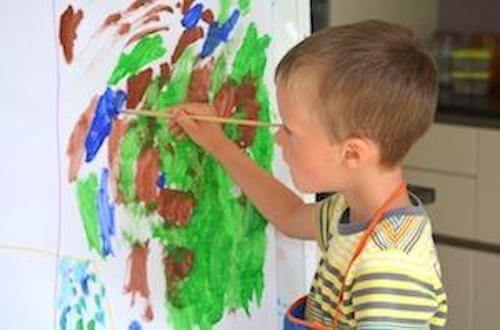There are many benefits of creative thinking, and it is important to encourage this from an early age. Creativity helps children with learning skills, social skills, and self-confidence. Studies have shown that by engaging in creative thought during our developmental years, we become better equipped to handle all sorts of challenges and situations we’re bound to encounter on our life journey. When we talk about creativity it is common to think of professions such as artist, sculptors, or actors, however, by doing this, we are overlooking all other aspects of life as creativity is universally applicable.
Creativity is far more about the process than the outcome. By experimenting it enables us to find our strengths and weaknesses, our likes and dislikes, and it fosters our emotional expression. It allows us to find out who we are, and it fills us with the confidence to be that person.
Below are some ways in which you can encourage your child’s creativity (and your own), and in doing so provide you with opportunities to further connect with them.
How to encourage your child’s creativity:
1. Have a creative space. You need to provide sufficient space in your home that allows your child to explore their creativity. Being in a cluttered area can be distracting and stifle creativity (this can also be said about workspace). It may be a space on the floor where they can use building blocks or a clear spot on the table for them to draw. Having this space, on the desk, for example, allows them to spread out and see all their options clearly, inspiring them to use a wider variety of colours and also use those colours in a creative way.

2. Expand their senses. Get them out of the house when you can. It is important to show them a wide range of different environments as it allows them to engage in ways which they have previously not experienced. It does not have to be a big trip, just something different. Take them somewhere in which they have an interest. If they like animals, the zoo is an easy option. If they love transport vehicles why not look for an exhibition nearby? Take them on a trip to the library and let them pick out a book to read. There is so much happening around us that sometimes all you need to do is to look, and you can find the perfect day out.
3. Encourage creativity by using stimulus. Creativity is not something that comes easily to everyone. It may sound silly, but it takes practice. Often trying to start a creative project (a story for example) can be the hardest part. Don’t be afraid to get some help. Try finding a simple picture, something that isn’t too busy and has a clear focal point. Let’s say you choose a picture of an animal running across an open field. Start the creative process by asking questions. Why is it running? Where is it running to? Does the animal have a name? Whereabouts do they come from? Does the animal have any special talents? By asking questions, you are making your child think. You are encouraging them to come up with explanations for what they can see, but also allowing them to provide details about what they cannot see.
4. Join in. As simple as it sounds. Children learn so much by watching others, and in the creative department, this is no different. By being creative with them, you can provide fresh ideas and new ways of approaching problems that they would otherwise not be exposed to. By being involved, you can also help guide them if they get stuck and encourage them to continue. Not to mention the quality time you will be spending together will strengthen your relationship.
5. Don’t shut down ideas. It is easy to be dismissive and brush off ideas that your child has come up with. Responses such as “That won’t work” or “That’s silly” can be damaging to your child’s creative confidence. Not all ideas are going to be good ideas, but at least your child is engaging their mind in a creative way, and that is what you want them to be doing. Be encouraging of their ideas and get them to elaborate. For example, if your child says that they are going to go to the moon ask them how they plan to achieve that. You can also add in problems that they may face on their journey – ask what will they do is aliens attack them on the trip. By doing this, you are building upon their ideas with them and making them go beyond their base idea.

6. Make them come up with more than one solution. By making them come up with another solution you are developing their problem-solving skills. Often in life, there is more than one of to fix a problem. By practising this from an early age, your child can build strong problem-solving skills which can be applied to a wide range of situations. Going back to the previous example of going to the moon – try asking how they plan to get there if their first solution failed. You can phrase these questions more subtly as well. Instead of saying that their first method didn’t work ask how they would get their sibling or pet to the moon as well (don’t let them take the easy option of taking and say they will take the same spaceship).
7. Avoid being too controlling. Easier said than done. It is important to let your child explore and create freely. Too many rules can be restricting and stunt their creative growth. Yes, set boundaries but not ones so strict that they stop your child from being able to experiment properly. Just as it is important to be hands-on with your children, it is also important to be hands-off. They need to be able to find things out for themselves and have control over what they choose to draw, make, or what story to tell. Telling them what to do can reduce their ability to think flexibly.
8. Know that failures are OK. Trial and error is a large part of the learning process, and you use your mistakes to learn. It is important to your development that you fail sometimes. By being exposed to those feelings you are better able to understand them, and in turn, handle them.
9. Emphasise the process rather than the product. This was mentioned earlier, but it is important. The creative journey is far more beneficial than the end result. The skills and lessons learned by experimenting equip us for the journey ahead.
If you are looking for some ideas on how to set up fun, engaging activities for your child, why not try making your own playdough? A good recipe can be found here. Getting your child to mould their ideas out of playdough is a great way for them to express themselves, not to mention the money you save by making it yourself.
The world is but a canvas to our imaginations
~ Henry Thoreau
To discover more about parenting and children, click here.








